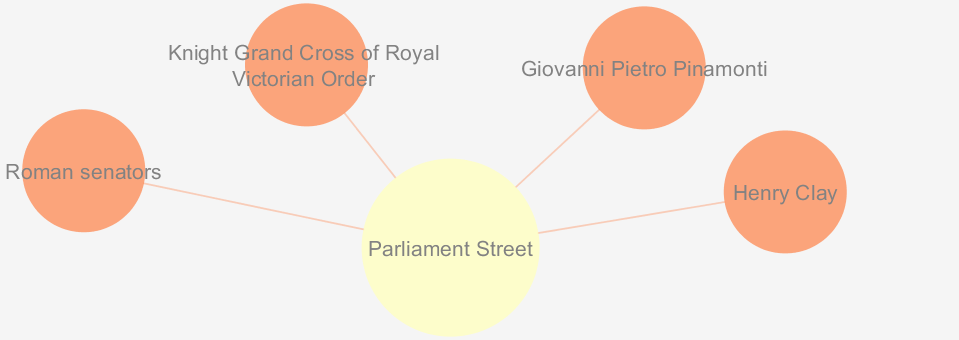Parliament Street
Map
The following is a map of Parliament Street:

About this Location
Parliament Street is a street in Dublin, Ireland on the South Bank of the Liffey. It is featured in the "Wanderings of Ulysses" section of Ulysses.
Network Graph

Most Common References
In Parliament Street, references to Henry Clay, Roman senators, the Knight Grand Cross of Royal Victorian Order, and Giovanni Pietro Pinamonti were made.
Henry Clay (1777-1852) was an American politician who served as a congressman and a senator.
Roman senators were men who served on the Roman Senate.
The Knight Grand Cross of Royal Victorian Order is a title bestowed on a man who has been inducted into the Royal Victorian Order. This title, the GCVO, is the highest class one can obtain when inducted into the RVO.
Father Giovanni Pietro Pinamonti (1632-1702) was an Italian Jesuit who wrote several books, including The Nun in Solitude and The Victorious Vocation.
This Location in Ulysses
The allusions featured in Parliament Street include references to American politics, Italian clergymen, Roman senators, and prestigious awards appointed by the British crown. Henry Clay was a strong promoter of Missouri Compromise of 1820 and the Compromise of 1850, both of which were designed to keep America from falling apart over slavery. Pinamonti, as a Jesuit, was a Catholic missionary, and he wrote several accounts of his experiences. Jesuits, as Christian missionaries, were concerned partly with converting the foreigners they came into contact with to Catholicism. In a way, they hope to unite the world under the authority of the Catholic church. The Royal Victorian Order is an order like the Jesuits are a Catholic order, but the RVO was instated to reward individuals who gave services to the British monarch, and individuals are appointed to this order not for religious reasons but solely by the power of the British monarch. Roman senators were wealthy men who governed and advised the Roman Empire, and the influence and power of these Italian men increased over time during the stay of the empire. Therefore, while this is somewhat an eclectic mix of allusions with seemingly few connections, conjectures can be made about Joyce's intention to speak of bringing some type of unity, as Henry Clay and Pinamonti did, and also of collections of distinctive peoples, such as Roman senators or Knights of the Grand Cross of the Royal Victorian Order.